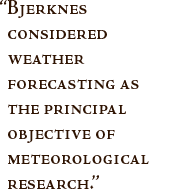

|
After two years as a lecturer at the Hogskola (School of Engineering) in Stockholm, Bjerknes became a professor of applied mechanics and mathematical physics at the University of Stockholm in 1895. Two years later he discovered the circulation theorems that led him to a synthesis of hydrodynamics and thermodynamics applicable to large-scale motions in the atmosphere and oceans. He then began devising a research plan that would use these theorems to compute the future state of the atmosphere given its present (initial) condition. This work ultimately resulted in the theory of air masses and fronts. As a primary piece of the modern weather forecasting puzzle, this theory described the life cycle of mid-latitude weather systems (low pressure systems). On November 2, 1897, Bjerknes' son Jacob was born. Jacob would later collaborate with his father and become a famous meteorologist in his own right, discovering the mechanism that controls the behavior of mid-latitude cyclones. In a programmatic paper published in 1904, Bjerknes proposed the procedure now known as numerical weather prediction. He suggested that weather prognosis (forecasting) should be considered as an initial value problem of mathematical physics, and could be carried out by integrating the governing equations forward in time, starting from the observed, initial state of the atmosphere. In short, Bjerknes discovered that with enough information about the current state of the atmosphere, scientists can use math formulas to predict future weather patterns. Unfortunately, due to the lack of processing facilities (computers), the calculations he envisioned were not feasible at that time. Nevertheless, Bjerknes considered weather forecasting as the principal objective of meteorological research, trusting that adequate observations and computer facilities would emerge in the future.
In 1905, during a trip to the United States, Bjerknes presented his research on the theory of how air masses move and explained his plans to apply mathematics to weather forecasting. The Carnegie Institution was so impressed they awarded him a grant to pursue his research interests. He would continue to receive their support until 1941. After chairing the Department of Applied Mechanics and Mathematical Physics at the University of Kristiania for five years, Bjerknes accepted the chair of geophysics at the University of Leipzig (Germany), and the directorship of the new Leipzig Geophysical Institute in 1912. He was joined by many of his Kristiania colleagues, as well as his son Jacob, who also became a collaborator during his time at Leipzig. Together, father and son established a network of weather observing stations in Norway. The data gathered from these stations would eventually lead to the development of their theory of polar fronts. next: Continuing the Saga
|
 On the Shoulders of Giants
| ||